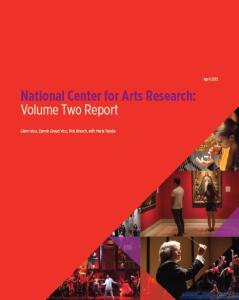
Author:
Publication Year: 2015
Media Type: Report
Summary:
"Welcome to the second NCAR Report, in which we share evidence-‐based insights into the health of US arts and cultural organizations. There is no one-‐size-‐fits-‐all performance measure or objective for such a diverse field, only answers to relevant questions that provide an array of useful measures and vantage points. Some anomalies also point to additional questions to explore. We care about numbers, not for their own sake, but because we believe that healthier arts and cultural organizations will have more resources to invest in artistic and cultural offerings and in community engagement." [Introduction]
Abstract:
"Welcome to the second NCAR Report, in which we share evidence-‐based insights into the health of US arts and cultural organizations. There is no one-‐size-‐fits-‐all performance measure or objective for such a diverse field, only answers to relevant questions that provide an array of useful measures and vantage points. Some anomalies also point to additional questions to explore. We care about numbers, not for their own sake, but because we believe that healthier arts and cultural organizations will have more resources to invest in artistic and cultural offerings and in community engagement.
We organize the report into five broad sections.
1. Modeling the Arts & Culture Ecosystem We conceptualize the arts and culture ecosystem as a set of interdependent relationships among individual artists, arts organizations, their communities and audiences, and the cultural policies that influence the production and consumption of arts and culture. This section documents our data sources and details both how we organize arts & culture organizations into 11 arts sectors and how we organize them by size. We also provide details on how we created the spatial model that mathematically models the distances between arts & cultural organizations and their communities and audiences.
2. Reporting on Average Performance For each of the 26 indices, we report and provide highlights on the 2012 results for: 1) the average for all arts and cultural organizations, 2) the average by arts and cultural sector, and 3) the average by organizational size (i.e., total operating budget). In each case we report the index average (a ratio) as well as the average for its component parts: the numerator and denominator of the index (each a general number). We then report the index average by geographic market cluster and provide some additional traits of these clusters. For those who want to see what averages were in prior years, we provide the index averages for 2008 through 2011.
3. What Drives Performance We don’t want to only report on ‘what performance was,’ we want to dig deeper to see what drives performance on every measure. Combining organizational data with our spatial model, we examine a host of predictors of performance for the numerators and denominators used in the indices. These predictors include the organizational activities, practices and decisions that impact performance. But arts and cultural organizations don’t operate in a vacuum, they operate in communities. So, we use the spatial model to explore community and cultural policy factors that positively or negatively impact performance.
4. Identifying High Performance and Key Intangible Performance Indicators (KIPIs) The same models that examine what Arts & Culture Ecosystem factors predict performance also produce Key Intangible Performance Indicators (KIPIs) that estimate the intellectual capital – i.e., unobservable managerial and artistic expertise – that drives organizational performance on each index. 1 Page 3 Page 84 Page 136 Page 11
5. Where We Go From Here Going forward, we will integrate new data as they become available, continue to refine our analytic techniques, and examine the additional indices that you are most interested in. We also are working with IBM to bring you an online dashboard that will provide you with your organization’s individual KIPI scores." [Introduction p. 1-2]
Arts & Intersections:
Categories: Local Arts Agencies, Funding, Federal, Economic Impact
ADDITIONAL BIBLIOGRAPHICAL INFORMATION
PUBLISHER INFORMATION
Name: National Center for Arts Research
Website URL: http://mcs.smu.edu/artsresearch2014/